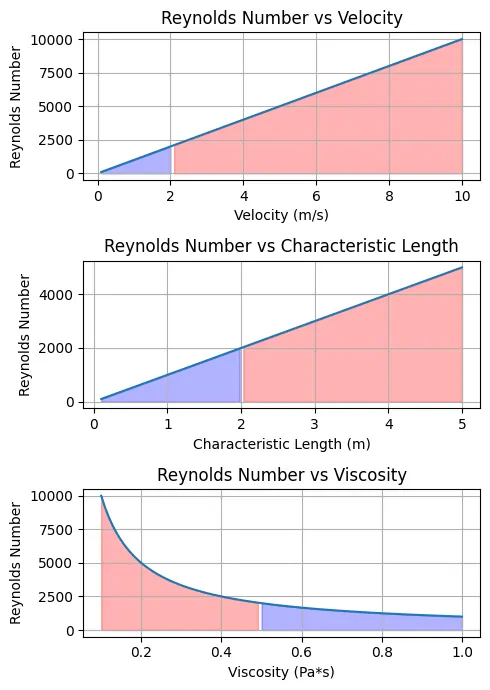Table of Contents
What is Reynolds Number?
The Reynolds number is a dimensionless quantity used in fluid dynamics to predict the type of flow pattern, whether it’s laminar or turbulent, in a pipe. It’s defined by the ratio of inertial forces to viscous forces.

The formula for Reynolds number is given by:
\[ Re = \frac{\rho V D}{\mu} \]
where:
- \( Re \) is the Reynolds number
- \( \rho \) is the density of the fluid
- \( V \) is the velocity of flow
- \( D \) is the pipe diameter
- \( \mu \) is the viscosity of the fluid
For the circular pipe, if Re calculated is high (greater than 2000), then the flow through the pipe is said to be turbulent. If Re is low (less than 2000), the flow is said to be laminar.
Related: Newton’s Law of Viscosity Calculator – Dynamic Viscosity
Related: Hagen-Poiseuille Equation Calculator / Poiseuille’s Law Solver
Reynolds Number Calculator
This calculator computes the Reynolds number for a fluid flow based on user inputs for fluid density (ρ), flow speed (u), characteristic length (L), and dynamic viscosity (μ). After clicking the “Calculate” button, user gets calculated number and a message indicating the type of flow (laminar, turbulent, or transitional).
Note: User can choose the characteristic length for the given geometry of the flow situation.
Related: Other Fluid Mechanics Calculators
Characteristic Length Table for Reynolds number calculation
| Flow Situation | Characteristic Length (L) | Description |
|---|---|---|
| Flow over a flat plate | Length of the plate | The characteristic length is the length of the plate over which the fluid is flowing. |
| Flow inside a pipe or duct | Hydraulic diameter | The hydraulic diameter is defined as four times the cross-sectional area of the pipe divided by the wetted perimeter of the pipe. It is used as the characteristic length for flow inside a pipe or duct. |
| Flow around a cylinder | Diameter of the cylinder | The characteristic length is the diameter of the cylinder around which the fluid is flowing. |
| Flow around a sphere | Diameter of the sphere | The characteristic length is the diameter of the sphere around which the fluid is flowing. |
Reynolds Number Derivation
The Reynolds number is defined as the ratio of inertial forces to viscous forces within a fluid.
\(R_e = \frac{inertial force}{viscous force}\)
Let’s consider a fluid of density (\( \rho \)) is flowing with velocity (\( v \)) over a characteristic length (\( L\)).
The mass of the fluid per second, ( \( \Delta m \)), is given by the volume of fluid flowing per second multiplied by the density, which is (\( A \cdot v \cdot \rho \)).
The inertial force per unit area is then given by the rate of change of momentum divided by the area, which is
\( \frac{\Delta m \cdot v}{A} = \frac{A \cdot v \cdot \rho \cdot v}{A} = \rho \cdot v^2 \).
The viscous force, ( F ), is given by (\( \eta \cdot A \cdot \frac{v}{L} \)), where ( \(\frac{v}{L}\) ) is the velocity gradient between the layers of the liquid flow.
The viscous force per unit area is then
\( \frac{F}{A} = \eta \cdot \frac{v}{L}\)
Therefore, substituting the above expressions, we get:
\( R_e = \frac{\rho \cdot v^2}{\eta \cdot \frac{v}{L}} = \frac{v \cdot \rho \cdot L}{\eta} \)
This is the mathematical expression, that provides insight into the flow regime of a fluid, whether it’s laminar or turbulent. The characteristic length ( L ) is chosen based on the specific flow situation as shown in table above.
Related: 10 Mostly used Dimensionless Numbers in Chemical Engineering
Other Dimensionless Numbers
Here we have tabulated the list of dimensionless numbers which are commonly used in Chemical Engineering with their formula, definition, and significance.
| Dimensionless Number | Formula | Definition | Significance |
|---|---|---|---|
| Reynolds Number (Re) | \[\text{Re} = \frac{\rho u L}{\mu} = \frac{u L}{\nu}\] | Ratio of inertial forces to viscous forces. | Determines flow regime: Re < 2000: Laminar flow Re > 4000: Turbulent flow. Critical for pipe flow and reactors. |
| Prandtl Number (Pr) | \[\text{Pr} = \frac{C_p \mu}{k}\] | Ratio of momentum diffusivity to thermal diffusivity. | It indicates the relative thickness of momentum and thermal boundary layers in heat transfer. |
| Nusselt Number (Nu) | \[\text{Nu} = \frac{h L}{k}\] | Ratio of convective to conductive heat transfer. | It is used in convective heat transfer problems to evaluate heat transfer coefficients. |
| Sherwood Number (Sh) | \[\text{Sh} = \frac{k_m L}{D}\] | Ratio of convective to diffusive mass transfer. | It is important in mass transfer, especially in diffusion and absorption processes. |
| Péclet Number (Pe) | \[\text{Pe} = \text{Re} \cdot \text{Pr}\] | Ratio of advection to diffusion. Combines Reynolds and Prandtl numbers. | It is important in heat and mass transfer processes where advection dominates over diffusion. |
| Schmidt Number (Sc) | \[\text{Sc} = \frac{\mu}{\rho D}\] | Ratio of momentum diffusivity to mass diffusivity. | It is used in mass transfer to relate momentum and mass transport. Analogous to the Prandtl number in heat transfer. |
| Lewis Number (Le) | \[\text{Le} = \frac{\alpha}{D} = \frac{\text{Sc}}{\text{Pr}}\] | Ratio of thermal diffusivity to mass diffusivity. | It relates thermal and mass transport; Le = 1 implies similar thermal and mass diffusivity. |
| Fourier Number (Fo) | \[\text{Fo} = \frac{\alpha t}{L^2}\] | Ratio of heat conduction rate to heat storage rate. | It is used in unsteady-state heat transfer problems, like transient conduction. |
| Biot Number (Bi) | \[\text{Bi} = \frac{h L}{k}\] | Ratio of internal thermal resistance to surface thermal resistance. | It determines whether heat conduction is lumped or distributed. Bi < 0.1: Lumped system approximation valid. |
| Weber Number (We) | \[\text{We} = \frac{\rho u^2 L}{\sigma}\] | Ratio of inertial forces to surface tension forces. | It is important in multiphase flows, droplet formation, and fluid interface stability. |
| Capillary Number (Ca) | \[\text{Ca} = \frac{\mu u}{\sigma}\] | Ratio of viscous forces to surface tension forces. | It is used to study the behavior of capillary flows and thin-film phenomena. |
| Froude Number (Fr) | \[\text{Fr} = \frac{u^2}{g L}\] | Ratio of inertial forces to gravitational forces. | It is important in free-surface flows, mixing, and fluidized bed design. |
| Damköhler Number (Da) | \[\text{Da} = \frac{\text{Reaction rate}}{\text{Flow rate}}\] | Ratio of chemical reaction time to residence time. | It is important in chemical reaction engineering; determines if a process is reaction- or transport-limited. |
| Thiele Modulus (ϕ) | \[\phi = L \sqrt{\frac{k}{D}}\] | Ratio of reaction rate to diffusion rate within a catalyst particle. | It is used in heterogeneous catalysis to determine diffusion limitations within catalyst pores. |
| Knudsen Number (Kn) | \[\text{Kn} = \frac{\lambda}{L}\] | Ratio of molecular mean free path to characteristic length. | It is important in gas flow through small pores or microchannels; indicates continuum vs. molecular flow regime. |
| Eckert Number (Ec) | \[\text{Ec} = \frac{u^2}{C_p \Delta T}\] | Ratio of kinetic energy to enthalpy difference. | It is used in high-speed flows and heat transfer problems involving viscous dissipation. |
| Grashof Number (Gr) | \[\text{Gr} = \frac{g \beta \Delta T L^3}{\nu^2}\] | Ratio of buoyancy forces to viscous forces. | It determines the importance of natural convection in heat transfer problems. |
| Stanton Number (St) | \[\text{St} = \frac{h}{\rho u C_p}\] | Ratio of heat transfer coefficient to the product of fluid velocity and specific heat. | It is used in heat transfer to describe convective heat transfer efficiency relative to bulk flow. |
Related: 10 Mostly used Dimensionless Numbers in Chemical Engineering
Example Problem on Reynolds Number
Determine the flow of fluid having a relative density of \(100 \, \text{kg/m}^3\), the viscosity of \(0.5 \, \text{Ns/m}^2\) with a velocity of \(5 \, \text{m/s}\) through a pipe of \(0.2 \, \text{m}\).
Given:
- Velocity of fluid, \(V = 5 \, \text{m/s}\)
- Diameter of pipe, \(D = 0.2 \, \text{m}\)
- Relative density of fluid, \(p = 100 \, \text{kg/m}^3\)
- Viscosity of fluid, \(\mu = 0.5 \, \text{Ns/m}^2\)
using formula \( \text{Re} = \frac{pVD}{\mu} \)
substituting given values in the formula we get:
\( \text{Re} = \frac{(100 \, \text{kg/m}^3) \times (5 \, \text{m/s}) \times (0.2 \, \text{m})}{0.5 \, \text{Ns/m}^2} \)
\(\text{Re} = 200 \)
Since the Re is less than \(2000\), the flow of liquid is laminar.
Also Read: Chemical Engineering as a career option in India
Python Code for Reynolds Number Calculation
This Python code helps user to calculate and visualizes the Reynolds number to predict flow patterns. This code plots the Reynolds number against three parameters: velocity, characteristic length, and viscosity, and showing them as subplots. The regions of laminar and turbulent flow regimes are highlighted on each plot with the variation in colors corresponding to different Re number ranges.
Note: This Python code solves the specified problem. Users can copy the code and run it in a suitable Python environment. By adjusting the input parameters, users can observe how the output changes accordingly.
import numpy as np
import matplotlib.pyplot as plt
def reynolds_number(density, velocity, length, viscosity):
"""
Calculate Reynolds_number.
Parameters:
density (float): Fluid density (kg/m^3).
velocity (float): Flow velocity (m/s).
length (float): Characteristic length (m).
viscosity (float): Fluid viscosity (Pa*s).
Returns:
reynolds_number (float): Reynolds number.
"""
return density * velocity * length / viscosity
def plot_reynolds_vs_velocity(density, length, viscosity):
"""
Plot Reynolds number against velocity.
Parameters:
density (float): Fluid density (kg/m^3).
length (float): Characteristic length (m).
viscosity (float): Fluid viscosity (Pa*s).
"""
velocities = np.linspace(0.1, 10, 100)
reynolds_numbers = np.array([reynolds_number(density, velocity, length, viscosity) for velocity in velocities])
plt.subplot(3, 1, 1)
plt.plot(velocities, reynolds_numbers)
plt.fill_between(velocities, 0, reynolds_numbers, where=(reynolds_numbers <= 2000), color='blue', alpha=0.3)
plt.fill_between(velocities, 0, reynolds_numbers, where=(reynolds_numbers > 2000), color='red', alpha=0.3)
plt.xlabel('Velocity (m/s)')
plt.ylabel('Reynolds Number')
plt.title('Reynolds Number vs Velocity')
plt.grid(True)
def plot_reynolds_vs_length(density, velocity, viscosity):
"""
Plot Reynolds_number against characteristic length.
Parameters:
density (float): Fluid density (kg/m^3).
velocity (float): Flow velocity (m/s).
viscosity (float): Fluid viscosity (Pa*s).
"""
lengths = np.linspace(0.1, 5, 100)
reynolds_numbers = np.array([reynolds_number(density, velocity, length, viscosity) for length in lengths])
plt.subplot(3, 1, 2)
plt.plot(lengths, reynolds_numbers)
plt.fill_between(lengths, 0, reynolds_numbers, where=(reynolds_numbers <= 2000), color='blue', alpha=0.3)
plt.fill_between(lengths, 0, reynolds_numbers, where=(reynolds_numbers > 2000), color='red', alpha=0.3)
plt.xlabel('Characteristic Length (m)')
plt.ylabel('Reynolds Number')
plt.title('Reynolds Number vs Characteristic Length')
plt.grid(True)
def plot_reynolds_vs_viscosity(density, velocity, length):
"""
Plot Reynolds_number against viscosity.
Parameters:
density (float): Fluid density (kg/m^3).
velocity (float): Flow velocity (m/s).
length (float): Characteristic length (m).
"""
viscosities = np.linspace(0.1, 1, 100)
reynolds_numbers = np.array([reynolds_number(density, velocity, length, viscosity) for viscosity in viscosities])
plt.subplot(3, 1, 3)
plt.plot(viscosities, reynolds_numbers)
plt.fill_between(viscosities, 0, reynolds_numbers, where=(reynolds_numbers <= 2000), color='blue', alpha=0.3)
plt.fill_between(viscosities, 0, reynolds_numbers, where=(reynolds_numbers > 2000), color='red', alpha=0.3)
plt.xlabel('Viscosity (Pa*s)')
plt.ylabel('Reynolds Number')
plt.title('Reynolds Number vs Viscosity')
plt.grid(True)
# Example usage:
density = 1000 # kg/m^3
velocity = 1 # m/s
length = 1 # m
plt.figure(figsize=(5, 7))
plot_reynolds_vs_velocity(density, length, velocity)
plot_reynolds_vs_length(density, velocity, length)
plot_reynolds_vs_viscosity(density, velocity, length)
plt.tight_layout()
plt.show()Output:

Resources
- “Fluid Mechanics” by Frank M. White
- “Introduction to Fluid Mechanics” by Robert W. Fox, Alan T. McDonald, and Philip J. Pritchard
- “Principles of Heat and Mass Transfer” by Frank P. Incropera and David P. DeWitt
- Python.org – The official Python website offers tutorials, documentation, and resources for learning Python.
Disclaimer: The Solver provided here is for educational purposes. While efforts ensure accuracy, results may not always reflect real-world scenarios. Verify results with other sources and consult professionals for critical applications. Contact us for any suggestions or corrections.






